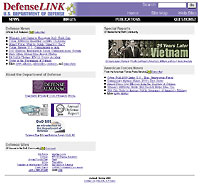DefenseLink site has open arms for diverse users

Connecting state and local government leaders
Webmasters for federal sites face the challenge of presenting a single public face instead of multiple personas. And the front door to any federal Web presence must have a single welcome mat for vastly different users.
 | The Defense Department's central Web site, DefenseLink, controls home page clutter while providing a wealth of information that is of interest to multiple groups of users. |
www.defenselink.mil
| DefenseLink at a glance |
| System details: Front end: A multiprocessor server runs Unix in a distributed environment of multiple application and service layers across other Unix systems. High-speed storage devices and high-capacity Internet connections: Because of ongoing concerns about hacker attacks, the Defense Technical Information Center would not reveal hardware and software specifics. File storage: DefenseLink and other DTIC Web servers share a dedicated, high-capacity 750G system on the DTIC LAN. Staff: Six people, including server, network and database administrators, share their time with other Defense Department Web services. As host, DTIC supports the technical infrastructure. DTIC and the American Forces Information Service help out with a diverse, shared staff of up to 10 programmers, four graphics specialists, two Web strategists and a technical writer. Page views: The count of about 1 million views per week, or about 142,860 per day, is rising steadily. Applications: Homegrown applications use Perl scripts and Apple WebObjects. Content providers and managers upload and edit files from various interfaces. Back end: The system uses Oracle Corp. relational databases. Key staff: Chris Unger, DefenseLink project manager, American Forces Information Service; Terry Davis, DefenseLink technical manager, Defense Technical Information Center; Bob Harner, lead software engineer under contract from DynCorp of Reston, Va.; Harold Heilsnis, director for public communications, Office of the Assistant Secretary of Defense for Public Affairs; Navy Capt. Tim Taylor, director of Defense information, Office of the Assistant Secretary of Defense for Public Affairs; Army Col. Mitchell Marovitz, director of media operations, American Forces Information Service. |
Navigate with ease
Shawn P. McCarthy designs products for a Web search engine provider. E-mail him at smccarthy@lycos.com.
| What's good, what needs work |
 'News stories on the front page rotate daily and sometimes hourly for breaking news. 'News stories on the front page rotate daily and sometimes hourly for breaking news.'The news area combines feeds from multiple sources: the Defense Department news service, the Directorate of Defense Information, the American Forces Press Service and DOD press offices. 'There's a news photo archive and RealAudio sound files of press briefings. One area even lists newly signed contracts'public information that every federal site ought to provide. 'The 'news by e-mail' sign-up feature keeps everyone informed and takes a load off the Web server because newshounds need not visit constantly. There are 30,000 subscribers. 'Information about top DOD leaders, posted on the front page, points to their offices and contact points. 'Page weight is acceptable throughout. The designers took care to reduce the size of graphics and to present information in digestible chunks. 'A Web specials area rotates items every few weeks, highlighting special projects unobtrusively and effectively. An archive is available.  'Although the scrolling menu reduces clutter on the front page, it masks the range of information offered and increases the risk that visitors will miss the particular resources they seek. It would be better to show all major sections in a clickable directory. 'DOD 101 is a great resource, but the converted PowerPoint-like presentation has no embedded links. The designers should redo it with hyperlinks. 'Integration of content into search results could be better, both inside DefenseLink and across other Defense Department sites. For example, a search for news leads to old news stories and fails to recommend DefenseLink's own central news page. Search results also miss the full breadth of what's available. 'Visitors should be able to search individual directories. The publications area can target a search to publications only. It would be good to do the same thing in the budget area, the Defense Almanac area and so on. 'Cross-pollination could be better between the DefenseLink site, the service's Web sites, and even the State Department and White House sites. |




